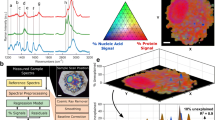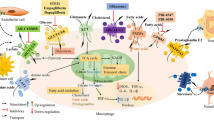Abstract
Macrophages reside in every tissue of the body and are the first-line of defense of the immune system. Their function is to entrap apoptotic cells, pathogens, and other particles and produce immune effector cytokines. It has also been shown that macrophages sequester xenobiotics, particularly lysosomotropic agents. One of the well-known and best studied lysosomotropic agents is the weakly basic antibiotic clofazimine. Interestingly, not all macrophages within a population, such as those present in a particular tissue or organ, accumulate xenobiotics to the same extent. Within every general population of macrophages, there is a distinct subpopulation of macrophages that express the xenobiotic sequestering phenotype. Thus, in this chapter, we explain how one can utilize clofazimine as a probe to explore the physical and biological markers that can ultimately distinguish this xenobiotic sequestering subpopulation of macrophages, specifically among the alveolar macrophages isolated from the lungs of mice treated with oral clofazimine for a period of several weeks. The experimental approach and the rationale behind choosing each marker is also explained. As a result, out of various biological markers (i.e., TLR2, TLR4, CLC7, TFEB, p65, V-ATPase) and physical markers (i.e., cell area and size), the physical markers were most closely associated with the xenobiotic sequestering subpopulation of macrophages. Other investigated molecular markers showed no statistically significant association with the xenobiotic sequestering phenotype. Some markers exhibited differences, but the variability in the phenotype rendered them a less reliable marker as compared to the associated increase in cell area and size.
Access this chapter
Tax calculation will be finalised at checkout
Purchases are for personal use only
Similar content being viewed by others
References
Nature reviews: immunology. Monocytes and macrophages. 2011 [cited 2016 Aug 19]. http://www.nature.com/nri/focus/macrophages/index.html?WT.ec_id=SLBU_COMMS
Kaufmann AM, Krise JP (2007) Lysosomal sequestration of amine-containing drugs: analysis and therapeutic implications. J Pharm Sci 96(4):729–746
Funk RS, Krise JP (2012) Cationic amphiphilic drugs cause a marked expansion of apparent lysosomal volume: implications for an intracellular distribution-based drug interaction. Mol Pharm 9(5):1384–1395
Logan R et al (2014) Amine-containing molecules and the induction of an expanded lysosomal volume phenotype: a structure-activity relationship study. J Pharm Sci 103(5):1572–1580
Logan R, Kong AC, Krise JP (2014) Time-dependent effects of hydrophobic amine-containing drugs on lysosome structure and biogenesis in cultured human fibroblasts. J Pharm Sci 103(10):3287–3296
Sardiello M et al (2009) A gene network regulating lysosomal biogenesis and function. Science 325(5939):473–477
Visvikis O et al (2014) Innate host defense requires TFEB-mediated transcription of cytoprotective and antimicrobial genes. Immunity 40(6):896–909
Settembre C et al (2013) Signals from the lysosome: a control centre for cellular clearance and energy metabolism. Nat Rev Mol Cell Biol 14(5):283–296
Arbiser JL, Moschella SL (1995) Clofazimine: a review of its medical uses and mechanisms of action. J Am Acad Dermatol 32(2 Pt 1):241–247
Dey T et al (2013) Outcomes of clofazimine for the treatment of drug-resistant tuberculosis: a systematic review and meta-analysis. J Antimicrob Chemother 68(2):284–293
World Health Organization. Leprosy report. 2014 [cited 2016 Aug 16]. http://www.who.int/mediacentre/factsheets/fs101/en
Baik J, Rosania GR (2012) Macrophages sequester clofazimine in an intracellular liquid crystal-like supramolecular organization. PLoS One 7(10):e47494
Baik J, Rosania GR (2011) Molecular imaging of intracellular drug-membrane aggregate formation. Mol Pharm 8(5):1742–1749
Baik J et al (2013) Multiscale distribution and bioaccumulation analysis of clofazimine reveals a massive immune system-mediated xenobiotic sequestration response. Antimicrob Agents Chemother 57(3):1218–1230
Keswani RK et al (2015) Chemical analysis of drug biocrystals: a role for Counterion transport pathways in intracellular drug disposition. Mol Pharm 12(7):2528–2536
Rzeczycki P et al (2017) Detecting ordered small molecule drug aggregates in live macrophages: a multi-parameter microscope image data acquisition and analysis strategy. Biomed Opt Express 8(2):860–872
Keswani RK et al (2015) A far-red fluorescent probe for flow cytometry and image-based functional studies of xenobiotic sequestering macrophages. Cytometry A 87(9):855–867
Yoon GS et al (2015) Phagocytosed clofazimine biocrystals can modulate innate immune signaling by inhibiting TNFalpha and boosting IL-1RA secretion. Mol Pharm 12(7):2517–2527
Abcam (2020) Immunocytochemistry and immunofluorescence protocol. https://www.abcam.com/protocols/immunocytochemistry-immunofluorescence-protocol
Murashov MD et al (2018) The physicochemical basis of Clofazimine-induced skin pigmentation. J Invest Dermatol 138(3):697–703
Murashov MD et al (2018) Synthesis and characterization of a biomimetic formulation of clofazimine hydrochloride microcrystals for parenteral administration. Pharmaceutics 10(4)
Schneider CA, Rasband WS, Eliceiri KW (2012) NIH image to ImageJ: 25 years of image analysis. Nat Methods 9(7):671–675
Woldemichael T, Rosania GR (2017) The physiological determinants of drug-induced lysosomal stress resistance. PLoS One 12(11):e0187627
Morissette G, Lodge R, Marceau F (2008) Intense pseudotransport of a cationic drug mediated by vacuolar ATPase: procainamide-induced autophagic cell vacuolization. Toxicol Appl Pharmacol 228(3):364–377
Ayala-Cuellar AP, Cho J, Choi KC (2019) Toll-like receptors: a pathway alluding to cancer control. J Cell Physiol 234(12):21707–21715
Kawasaki T, Kawai T (2014) Toll-like receptor signaling pathways. Front Immunol 5:461
Majewska M, Szczepanik M (2006) The role of Toll-like receptors (TLR) in innate and adaptive immune responses and their function in immune response regulation. Postepy Hig Med Dosw (Online) 60:52–63
Hopkins PA, Sriskandan S (2005) Mammalian toll-like receptors: to immunity and beyond. Clin Exp Immunol 140(3):395–407
Rehli M et al (1999) Cloning and characterization of the murine genes for bHLH-ZIP transcription factors TFEC and TFEB reveal a common gene organization for all MiT subfamily members. Genomics 56(1):111–120
Palmieri M et al (2011) Characterization of the CLEAR network reveals an integrated control of cellular clearance pathways. Hum Mol Genet 20(19):3852–3866
Schlissel MS, Baltimore D (1989) Activation of immunoglobulin kappa gene rearrangement correlates with induction of germline kappa gene transcription. Cell 58(5):1001–1007
Sen R, Baltimore D (1986) Multiple nuclear factors interact with the immunoglobulin enhancer sequences. Cell 46(5):705–716
Nolan GP et al (1991) DNA binding and I kappa B inhibition of the cloned p65 subunit of NF-kappa B, a rel-related polypeptide. Cell 64(5):961–969
Baeuerle PA, Baltimore D (1988) I kappa B: a specific inhibitor of the NF-kappa B transcription factor. Science 242(4878):540–546
Baeuerle PA, Baltimore D (1988) Activation of DNA-binding activity in an apparently cytoplasmic precursor of the NF-kappa B transcription factor. Cell 53(2):211–217
Mindell JA (2012) Lysosomal acidification mechanisms. Annu Rev Physiol 74:69–86
Finbow ME, Harrison MA (1997) The vacuolar H+-ATPase: a universal proton pump of eukaryotes. Biochem J 324(Pt 3):697–712
Dietz KJ et al (2001) Significance of the V-type ATPase for the adaptation to stressful growth conditions and its regulation on the molecular and biochemical level. J Exp Bot 52(363):1969–1980
Xu H, Ren D (2015) Lysosomal physiology. Annu Rev Physiol 77:57–80
Santa Cruz Biotechnology. CLC-7 Antibody (C-15): sc-16444. 2016 [cited 2016 Aug 22]. http://www.scbt.com/datasheet-16444-clc-7-c-15-antibody.html
Leisle L et al (2011) ClC-7 is a slowly voltage-gated 2Cl(−)/1H(+)-exchanger and requires Ostm1 for transport activity. EMBO J 30(11):2140–2152
Wang SP et al (2002) Regulation of enhanced vacuolar H+-ATPase expression in macrophages. J Biol Chem 277(11):8827–8834
Hong L et al (2011) Alteration of volume-regulated chloride channel during macrophage-derived foam cell formation in atherosclerosis. Atherosclerosis 216(1):59–66
Jiang L et al (2012) Intracellular chloride channel protein CLIC1 regulates macrophage function through modulation of phagosomal acidification. J Cell Sci 125(Pt 22):5479–5488
Woldemichael T et al (2018) Reverse engineering the intracellular self-assembly of a functional mechanopharmaceutical device. Sci Rep 8(1):2934
Author information
Authors and Affiliations
Corresponding author
Editor information
Editors and Affiliations
Rights and permissions
Copyright information
© 2021 Springer Science+Business Media, LLC, part of Springer Nature
About this protocol
Cite this protocol
Murashov, M.D. (2021). Quantitative Phenotypic Analysis of Drug Sequestering Macrophage Subpopulations. In: Rosania, G.R., Thurber, G.M. (eds) Quantitative Analysis of Cellular Drug Transport, Disposition, and Delivery. Methods in Pharmacology and Toxicology. Humana, New York, NY. https://doi.org/10.1007/978-1-0716-1250-7_7
Download citation
DOI: https://doi.org/10.1007/978-1-0716-1250-7_7
Published:
Publisher Name: Humana, New York, NY
Print ISBN: 978-1-0716-1249-1
Online ISBN: 978-1-0716-1250-7
eBook Packages: Springer Protocols




